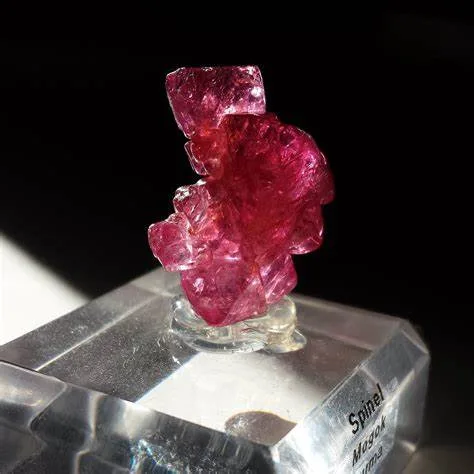
1. Chromium’s Geochemical Behavior
Chromium (Cr) is a lithophile element, meaning it concentrates in silicate minerals rather than metallic phases. Its distribution is strongly influenced by:
- Ultramafic and Mafic Rocks: Chromium is enriched in the Earth’s mantle, particularly in peridotites and chromitites.
- Metasomatism: Hydrothermal fluids can transport Cr, especially in subduction zones where serpentinization occurs.
- Oxidation State: Cr³⁺ is stable in most geological settings, while Cr⁶⁺ (toxic, water-soluble) forms in oxidizing environments.
Why Doesn’t Cr Occur in All Gemstones?
- Ionic Radius: Cr³⁺ (0.615 Å) closely matches Al³⁺ (0.535 Å), allowing substitution in corundum (ruby) and beryl (emerald).
- Incompatible Element: Cr does not fit well in quartz or feldspar structures, explaining its rarity in these minerals.
2. Ruby (Corundum, Al₂O₃) Formation

Rubies require:
- Aluminum-Rich, Silica-Deficient Environments (e.g., marble-hosted or basalt-related deposits).
- Chromium Source (typically from nearby ultramafic rocks).
Major Geological Settings for Rubies
A. Metamorphic (Marble-Hosted) Rubies
- Example: Mogok, Myanmar; Vietnam (Luc Yen).
- Formation Process:
- Limestones (CaCO₃) metamorphose into marble under high temperatures.
- Fluids from nearby mafic-ultramafic rocks introduce Cr into Al-rich corundum.
- Key Reaction:Al3+(in corundum)+Cr3+(from fluids)→Cr-doped Al2O3(ruby)Al3+(in corundum)+Cr3+(from fluids)→Cr-doped Al2O3(ruby)
B. Basalt-Related Rubies
- Example: Thailand, Cambodia, Australia.
- Formation Process:
- Alkali basalts transport ruby xenocrysts from the mantle.
- Chromium is sourced from mantle peridotites or eclogites.
C. Hydrothermal Rubies
- Example: Some African deposits (e.g., Malawi).
- Formation Process:
- Cr-rich fluids circulate through fractures, depositing ruby in shear zones.
3. Emerald (Beryl, Be₃Al₂Si₆O₁₈) Formation

Emeralds require:
- Beryllium (Be) + Chromium (Cr) in the Same Environment (rare!).
- Specific Tectonic Settings (usually pegmatites near ultramafic rocks or black shale-hosted deposits).
Major Geological Settings for Emeralds
A. Black Shale-Hosted Emeralds
- Example: Colombia (Muzo, Chivor).
- Formation Process:
- Organic-rich shales release Cr during metamorphism.
- Be is introduced by hydrothermal fluids from nearby granites.
- Key Reaction:Be2++Al3++Cr3++SiO44−→Be3Al2Si6O18:Cr3+(emerald)Be2++Al3++Cr3++SiO44−→Be3Al2Si6O18:Cr3+(emerald)
B. Pegmatite-Related Emeralds
- Example: Zambia, Brazil.
- Formation Process:
- Cr from nearby serpentinites reacts with Be-rich pegmatitic fluids.
C. Tectonic Shear Zone Emeralds
- Example: Madagascar, Afghanistan.
- Formation Process:
- Shearing creates pathways for Cr and Be-bearing fluids.
4. Why Are Some Emeralds Bluish-Green (Vanadium vs. Chromium)?
- Colombian Emeralds: Pure Cr³⁺ → intense green.
- Brazilian/Zambian Emeralds: Often contain Fe²⁺/Fe³⁺, modifying color to bluish-green.
- Vanadian Emeralds (e.g., Brazil): V³⁺ can substitute for Cr³⁺, producing slightly different green hues.
5. Exploration Implications
- Rubies: Look near marble/ultramafic contacts or alkali basalts.
- Emeralds: Focus on Be-rich pegmatites near Cr-bearing rocks or black shale zones.
Case Study: Colombian Emeralds
- Geological Oddity: The Andes’ tectonic compression forced Be-granites against Cr-shales, creating ideal emerald-forming conditions.
Conclusion
The presence of Cr in rubies and emeralds is a testament to rare geological coincidences—where Al/Be-rich systems intersect with Cr sources. Understanding these processes helps gemologists trace origins and aids miners in exploration.




































